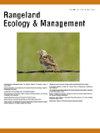Patchy Response of Cheatgrass and Nontarget Vegetation to Indaziflam and Imazapic Applied After Wildfire in Sagebrush Steppe
IF 2.4
3区 环境科学与生态学
Q2 ECOLOGY
引用次数: 0
Abstract
Control of nonnative grasses is needed where they are altering fire regimes and degrading rangelands, such as cheatgrass (Bromus tectorum) invasion of perennial sagebrush-steppe communities. Aerial broadcast of the pre-emergent and postemergent herbicide imazapic has been used for decades over vast areas to control cheatgrass after fire. Recent small-scale studies indicate that the pre-emergent herbicide indaziflam may provide more enduring cheatgrass control. We evaluated landscape-level vegetation responses to indaziflam sprayed in replicated areas at 66.7 g · ai · ha−1, with and without imazapic (66.1 g · ai · ha−1) over almost 500 ha of sagebrush steppe. Herbicides were strip-sprayed by helicopter in the fall of 2019 in subregions that either 1) had burned in the summer of 2019 and had moderate background cheatgrass invasion, 2) had burned in 2011 and became heavily invaded, or 3) were burned in both 2011 and 2019 and had intermediate invasion. Tarps were temporarily deployed to intercept herbicides and create untreated controls. Overall, indaziflam + imazapic had greater initial control of cheatgrass, but by 2023, both treatments led to similar ∼17 percentage-point reductions in cheatgrass cover. Cheatgrass individuals that “escaped” the herbicide treatment grew exceptionally large and fecund. There were no reductions in cover in any native vegetation type, including biocrusts, and nontarget increases in cover were observed for 1) deep-rooted perennial grasses treated with indaziflam + imazapic in the 2011 burn subregion and 2) the shallow-rooted Sandberg bluegrass (Poa secunda) treated with either herbicide in the 2011 or 2011 + 2019 burn subregions. Consideration of burn legacies, pretreatment landscape condition, and evenness of treatment application may improve restoration outcomes and help prioritize management allocation, timing, and treatment expectations.
山艾草原野火后落叶草和非目标植被对吲哚吡肟和异氮吡肟的斑片响应
在非本地草改变火种和退化牧场的地方,需要对它们进行控制,例如对多年生山艾草-草原群落的入侵。几十年来,在大片地区,空中播送出生前和出生前的除草剂imazapic,以控制火灾后的欺骗草。最近的小规模研究表明,萌发前除草剂吲唑氟兰可能提供更持久的欺骗草控制。在近500公顷的山艾草草原上,我们评估了在有和没有imazapic (66.1 g·ai·ha - 1)的情况下,在66.7 g·ai·ha - 1的重复喷洒区域,茚唑氟对景观级植被的响应。2019年秋季,在1)2019年夏季燃烧过并有中度背景草入侵的分区,2)2011年燃烧过并有严重入侵的分区,或3)2011年和2019年都燃烧过并有中度入侵的分区,用直升机对除草剂进行了带状喷洒。临时部署防水布来拦截除草剂并创建未经处理的控制。总体而言,indaziflam + imazapic对草的初始控制效果更好,但到2023年,两种处理导致草覆盖减少了17个百分点。“逃脱”除草剂处理的作弊草个体长得格外高大和多产。在2011年和2011年 + 2019年烧伤分区,包括生物结皮在内的所有原生植被类型的盖度都没有减少,但在1)深根多年生草(indaziflam + imazapic)和2)浅根桑德伯格蓝草(Poa secunda)(分别在2011年和2011年 + 2019年烧伤分区使用除草剂)的盖度都出现了非目标性的增加。考虑烧伤遗产、预处理景观条件和处理应用的均匀性可以改善修复结果,并有助于优先考虑管理分配、时间和处理预期。
本文章由计算机程序翻译,如有差异,请以英文原文为准。
求助全文
约1分钟内获得全文
求助全文
来源期刊

Rangeland Ecology & Management
农林科学-环境科学
CiteScore
4.60
自引率
13.00%
发文量
87
审稿时长
12-24 weeks
期刊介绍:
Rangeland Ecology & Management publishes all topics-including ecology, management, socioeconomic and policy-pertaining to global rangelands. The journal''s mission is to inform academics, ecosystem managers and policy makers of science-based information to promote sound rangeland stewardship. Author submissions are published in five manuscript categories: original research papers, high-profile forum topics, concept syntheses, as well as research and technical notes.
Rangelands represent approximately 50% of the Earth''s land area and provision multiple ecosystem services for large human populations. This expansive and diverse land area functions as coupled human-ecological systems. Knowledge of both social and biophysical system components and their interactions represent the foundation for informed rangeland stewardship. Rangeland Ecology & Management uniquely integrates information from multiple system components to address current and pending challenges confronting global rangelands.
 求助内容:
求助内容: 应助结果提醒方式:
应助结果提醒方式:


